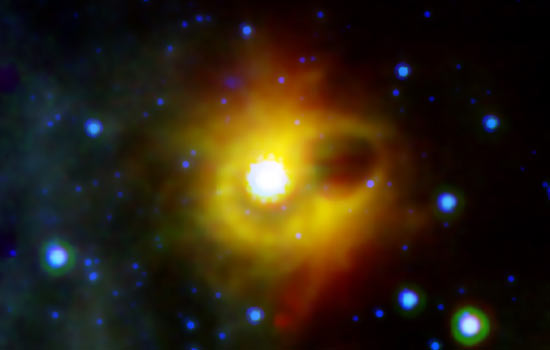Figer’s research leads to Nature report on celestial eruption
NASA/JPL-Caltech
This image shows a ghostly ring extending seven light-years around a collapsed star, called a magnetar, located at the center of this image. NASA's Spitzer Space Telescope imaged the mysterious ring in infrared light.
One of the most powerful eruptions in the universe might have spun an infrared ring around a rare and exotic star known as a magnetar—a highly magnetized neutron star formed in a brilliant supernova explosion of a massive star.
A paper published in the May 29 issue of Nature announces the detection of the elliptical ring or shell around the dead star known as SGR 1900+14. Observations obtained from NASA’s Spitzer Space Telescope in 2005 and 2007 suggest the ring was produced by a giant flare originally detected in 1998.
Stefanie Wachter, research scientist at NASA’s Spitzer Science Center at the California Institute of Technology, led the study, which links the origin of the magnetar to a nearby cluster of massive stars, whose light is dominated by two red supergiants at the center.
“Out of 400 billion stars in our galaxy, there are about a dozen magnetars that we know of,” says Donald Figer, professor at RIT’s Chester F. Carlson Center for Imaging Science and a co-author of the study. “Discovering the ring is groundbreaking because it discovers some other phenomenon associated with, and physically near, a magnetar. And when you know so little about an object, each new morsel you can gather up is very important.”
Figer is the director of the Rochester Imaging Detector Laboratory in the Carlson Center for Imaging Science. He joined RIT through a faculty development program grant awarded by the New York State Foundation for Science, Technology and Innovation. He is also part of a team, led by Rolf Kudritzki of University of Hawaii, who recently won time on the world’s largest telescope, the W.M. Keck Observatory, to make additional measurements of the magnetar. The stellar eruption may result from stress induced by the magnetic field dragging on the rapidly spinning star. A fissure in the surface of the magnetar creates a “starquake,” akin to earthquakes. The biggest variety of these eruptions can temporarily produce over a thousand times more energy than all of the stars in a galaxy.














